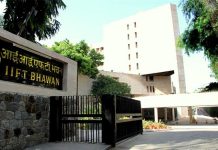Simple and Compound Interest Questions for IIFT PDF
Download important IIFT Simple and Compound Interest Questions PDF based on previously asked questions in IIFT and other MBA exams. Practice Simple and Compound Interest questions and answers for IIFT exam.
Download Simple and Compound Interest Questions for IIFT PDF
Get 50% Off on IIFT & Other MBA Test Series
IIFT Previous year question answer PDF
Practice IIFT Mock Tests
Question 1: Swarn a SME enterprise borrowed a sum of money from a nationalized bank at 10% simple interest per annum and the same amount at 8% simple interest per annum from a microfinance firm for the same period: It cleared the first loan 6 months before the scheduled date of repayment and repaid the second loan just at the end of the scheduled period: If in each case it had to pay Rs. 62100 as amount then how much money and for what time period did it borrow?
a) Rs. 55750, 2 years
b) Rs. 52500, 2 years
c) Rs. 51750, 2.5 years
d) Rs. 55750, 2.5 years
Question 2: Mr. Mehra is planning for higher education expenses of his two sons aged 15 and 12. He plans to divide Rs 15 lakhs in two equal parts and invest in two different plans such that his sons may have access to Rs 21 lakhs each when they reach the age of 21. He is looking for plans that will give him a simple interest per annum. The rates of interest of the plans for his younger son and his elder son should be
a) 5% and 7.5% respectively
b) 8% and 12% respectively
c) 10% and 15% respectively
d) 15 % and 22.5% respectively
e) 20% and 30% respectively
Question 3: Mr. Mishra invested Rs.25,000 in two fixed deposits X and Y offering compound interest @ 6% per annum and 8% per annum respectively. If the total amount of interest accrued in two years through both fixed deposits is Rs.3518, the amount invested in Scheme X is
a) Rs. 12,000
b) Rs. 13,500
c) Rs. 15,000
d) Cannot be determined
Question 4: Three years ago, your close friend had won a lottery of Rs. 1 crore. He purchased a flat for Rs. 40 lakhs, a car for Rs. 20 lakhs and shares worth Rs. 10 lakhs. He put the remaining money in a bank deposit that pays compound interest @ 12 percent per annum. If today, he sells off the flat, the car and the shares at certain percentage of their original value and withdraws his entire money from the bank, the total gain in his assets is 5%. The closest approximate percentage of the original value at which he sold off the three items is
a) 60 percent
b) 75 percent
c) 90 percent
d) 105 percent
Question 5: A sum of money compounded annually becomes Rs.625 in two years and Rs.675 in three years. The rate of interest per annum is
a) 7%
b) 8%
c) 6%
d) 5%
Question 6: In the beginning of the year 2004, a person invests some amount in a bank. In the beginning of 2007, the accumulated interest is Rs. 10,000 and in the beginning of 2010, the accumulated interest becomes Rs. 25,000. The interest rate is compounded annually and the annual interest rate is fixed. The principal amount is:
a) Rs. 16,000
b) Rs. 18,000
c) Rs. 20,000
d) Rs. 25,000
e) None of the above
Question 7: A man borrows 6000 at 5% interest, on reducing balance, at the start of the year. If he repays 1200 at the end of each year, find the amount of loan outstanding, in , at the beginning of the third year.
a) 3162.75
b) 4125.00
c) 4155.00
d) 5100.00
e) 5355.00
Question 8: To start a new enterprise, Mr. Yogesh has borrowed a total of Rs. 60,000 from two money lenders with the interest being compounded annually, to be repaid at the end of two years. Mr. Yogesh repaid Rs.38, 800 more to the first money lender compared to the second money lender at the end of two years. The first money lender charged an interest rate, which was 10% more than what was charged by the second money lender. If Mr. Yogesh had instead borrowed Rs. 30,000 from each at their respective initial rates for two years, he would have paid Rs.7, 500 more to the first money lender compared to the second. Then money borrowed by Mr. Yogesh from first money lender is?
a) 20,000
b) 35,000
c) 40,000
d) 42,000
Question 9: Mr. Mishra invested Rs.25,000 in two fixed deposits X and Y offering compound interest @ 6% per annum and 8% per annum respectively. If the total amount of interest accrued in two years through both fixed deposits is Rs.3518, the amount invested in Scheme X is
a) Rs. 12,000
b) Rs. 13,500
c) Rs. 15,000
d) Cannot be determined
Question 10: John borrowed Rs. 2,10,000 from a bank at an interest rate of 10% per annum, compounded annually. The loan was repaid in two equal instalments, the first after one year and the second after another year. The first instalment was interest of one year plus part of the principal amount, while the second was the rest of the principal amount plus due interest thereon. Then each instalment, in Rs., is
Top 500+ Free Questions for IIFT
IIFT Previous year question answer PDF
Answers & Solutions:
1) Answer (C)
The sum that was returned is same in both cases that means interest accrued is same in both cases.
Assume that the duration is ‘t’ years for which amount is borrowed in both case and principal amount is ‘P’.
$\frac{P*(t-0.5)*10} {100}$ = $\frac{P*t*8} {100}$
t=2.5 years
Principal amount that the enterprise borrowed :
$P(1+\frac{2*10}{100})$ =62100
P=51750
2) Answer (E)
Rs. 15 lakhs is to be divided equally.
In the case of the younger son,
Principal = Rs. 750000, time = 9 years and Interest = Rs. 1350000
Rate of interest = $\dfrac{1350000 * 100}{750000 * 9}$ = 20%
In the case of the elder son,
Principal = Rs. 750000, time = 6 years and Interest = Rs. 1350000
Rate of interest = $\dfrac{1350000 * 100}{750000 * 6}$ = 30%
Hence, option E is the correct answer.
3) Answer (C)
Let the amount invested in X = x
Thus, the amount invested in Y = 25000-x
The interest incurred = 3518 Rs, thus the total amount at the end of the 2nd year = 28518 Rs.
Thus, $x*(1.06)^2 + (25000-x)*(1.08)^2 = 28518$
=> $x*1.1236 + 25000*1.11664 – x*1.11664 = 28518$
=> $-0.0428x + 29160 = 28518$
=> $ 642 = 0.0428x$
Hence, $x = 15000 Rs$
Hence, option C is the correct answer.
4) Answer (C)
Hi total gain = 5%
Thus, the amount at the end of 3 years = 105 lakh Rupees
The amount he gets from the bank = $30(1.12)^2 = 42.14784$ lakh rupees
Let x be the percentage at which he sells the assets of worth 70 lakhs
Thus, the amount he gets = 0.7x lakhs
Thus, 70x + 42.1478 = 105
Thus, 70x = 62.8525
Thus, x is closest to 0.90= 90%
Hence, option C is the correct answer.
5) Answer (B)
As we know, formulae of compound interest for 2 years will be:
$P(1+\frac{r}{100})^{2}$ = 625 (Where r is rate, P is principal amount)
For 3 years:
$P(1+\frac{r}{100})^{3}$ = 675
Dividing above two equations we will get r=8%
6) Answer (C)
Let the principal amount = $P$ and rate of interest = $r \%$
Interest accumulated from 2004 to 2007 is Rs.10,000 and from 2004 to 2010 is Rs.25,000
Using, $C.I. = P[(1 + \frac{R}{100})^T – 1]$
=> $P[(1 + \frac{r}{100})^3 – 1] = 10,000$ ———-Eqn(I)
and $P[(1 + \frac{r}{100})^6 – 1] = 25,000$ ———–Eqn(II)
Dividing eqn(II) from (I), we get :
=> $\frac{P[(1 + \frac{r}{100})^6 – 1]}{P[(1 + \frac{r}{100})^3 – 1]} = \frac{5}{2}$
Let $(1 + \frac{r}{100})^3 = x$
=> $\frac{x^2 – 1}{x – 1} = \frac{5}{2}$
=> $2x^2 – 5x + 3 = 0$
=> $(2x – 3) (x – 1) = 0$
=> $x = \frac{3}{2} , 1$ $(x \neq 1)$ because then, r = 0
=> $(1 + \frac{r}{100})^3 = \frac{3}{2}$
Substituting it in eqn(I)
=> $P[\frac{3}{2} – 1] = 10,000$
=> $P = 10,000 \times 2 = 20,000$
7) Answer (C)
Amount man gets after 1 year
= $6000 + (\frac{6000 \times 5 \times 1}{100}) – 1200$
= $6000 + 300 – 1200 = 5100$
$\therefore$ Amount at the beginning of third year, i.e. after 2 years
= $5100 + (\frac{5100 \times 5 \times 1}{100}) – 1200$
= $5100 + 255 – 1200 = 4155$
8) Answer (C)
Let the interest on the second part be $r$ %
Then, the rate on the first part = ($r$ + 10)%It is given that,
$30000(1 + \dfrac{r + 10}{100})^2 – 30000(1 + \dfrac{r}{100})^2 = 7500$
On solving, we get $r$ = 20%
Let the first part be Rs. $a$
Then, the second part = Rs. (60000 – $a$)
$a(1 + \dfrac{20 + 10}{100})^2 – (60000 – a)(1 + \dfrac{20}{100})^2$ = 38800
On solving, we get $a$ = Rs. 40000
Hence, option C is the correct answer.
9) Answer (C)
Let the amount invested in X = x
Thus, the amount invested in Y = 25000-x
The interest incurred = 3518 Rs, thus the total amount at the end of the 2nd year = 28518 Rs.
Thus, $x*(1.06)^2 + (25000-x)*(1.08)^2 = 28518$
=> $x*1.1236 + 25000*1.11664 – x*1.11664 = 28518$
=> $-0.0428x + 29160 = 28518$
=> $ 642 = 0.0428x$
Hence, $x = 15000 Rs$
Hence, option C is the correct answer.
10) Answer: 121000
We have to equate the installments and the amount due either at the time of borrowing or at the time when the entire loan is repaid. Let us bring all values to the time frame in which all the dues get settled, i.e, by the end of 2 years.
John borrowed Rs. 2,10,000 from the bank at 10% per annum. This loan will amount to 2,10,000*1.1*1.1 = Rs.2,54,100 by the end of 2 years.
Let the amount paid as installment every year be Rs.x.
John would pay the first installment by the end of the first year. Therefore, we have to calculate the interest on this amount from the end of the first year to the end of the second year. The loan will get settled the moment the second installment is paid.
=> 1.1x + x = 2,54,100
2.1x = 2,54,100
=> x = Rs. 1,21,000.
Therefore, 121000 is the correct answer.
IIFT Previous year question answer PDF
We hope this Simple and Compound Interest questions and answers PDF will be helpful to you.





